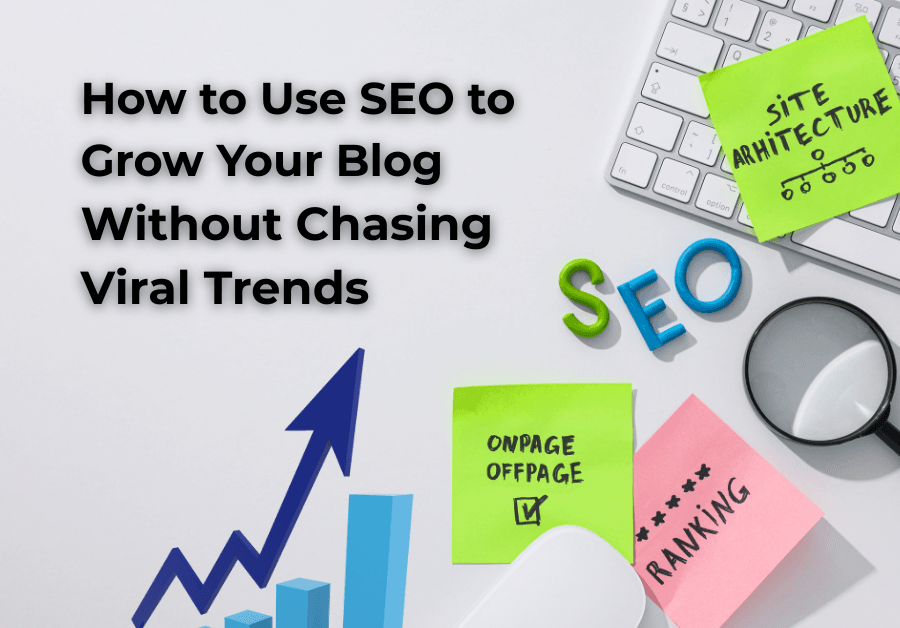How to Use SEO to Grow Your Blog Without Chasing Viral Trends
If you’re wondering how to use SEO to grow your blog without chasing viral trends, you’re not alone. Many content creators, especially those working behind the scenes, feel pressured to constantly jump on trending topics to stay relevant. But here’s the truth: strategic SEO can help you build a sustainable flow of traffic that doesn’t rely on luck or social media spikes.
In this post, we’ll break down the key steps you can take to grow your blog using proven SEO strategies—without compromising your brand or burning out.

Why SEO Should Be Your Blog’s Backbone
Unlike social media traffic, SEO delivers consistent, compounding results. Once your blog posts rank, they can continue attracting clicks for months (or years). That’s exactly why stealth marketers love SEO: you write once, and your blog works quietly in the background.
1. Start With Search Intent, Not Trends
Good SEO starts with knowing what your audience is actually searching for. Before you write anything, ask: What would my reader be Googling when they need this post? Tools like Google’s “People Also Ask”, Ubersuggest, Keywords everywhere, or Answer the Public can help you identify search intent. Once you know the question, your blog becomes the solution.
Example: A stealth creator selling Notion templates might search “how to rank Notion products on Google.” Writing a blog titled “SEO Tips for Digital Product Creators Using Notion” hits their exact need.
Tip: Use incognito Google search to see what questions and auto-fills come up when typing in your target phrase. That’s organic intent in action.
Related Search Resources:
2. Choose One Long-Tail Keyword Per Post
Long-tail keywords like “how to grow a blog with SEO” or “SEO for introvert creators” are easier to rank for—and more specific. Use your chosen keyword in:
- The blog title
- The first paragraph
- At least one subheading (like this one!)
- The image alt tag
- Your SEO meta description
Example: If your blog title is “How to Use SEO to Grow Your Blog Without Chasing Viral Trends,” that phrase should appear naturally in your intro, a subheading, and your meta description.
Tip: Keep a simple Notion table to track each blog post’s target keyword and where you’ve included it. Revisit this before you hit publish.
3. Add Value (and Clarity) to Every Paragraph
SEO rewards clarity. Keep your paragraphs short, your sentences concise, and your headings meaningful. Break up long content with clear subheadings that reflect user intent. Avoid fluff—every sentence should serve your reader.
Example: Instead of saying “There are a lot of ways to improve blog SEO,” clarify with, “Use tools like Rank Math or Yoast to check keyword usage, alt text, and content structure.”
Tip: Read your draft aloud. If you run out of breath or stumble, simplify the sentence. Clarity = SEO gold.
4. Use Internal Links to Build Authority
If you’ve written related posts (like your content strategy, keyword research, or blog monetization guides), link to them. Internal linking helps Google crawl your site and keeps visitors engaged.
Example: Mentioning “email list strategy”? Link to your post on “5 No-Fluff Ways to Build a Stealth Email List.”
OR 🔍 Read next: 5 Mistakes Beginners in Digital Marketing Make (and What to Do Instead)
Tip: After publishing, revisit the post monthly and add new internal links as your content library grows.
5. Add One or Two Helpful External Links
Outbound links to trusted sites (like Moz, Neil Patel, or Google Docs) show Google that your content plays well with others. Link naturally—don’t force it. For example:
“Want to check your on-page SEO? Try Neil Patel’s Ubersuggest.”
Example: Mentioned keyword clustering? Link to a high-authority blog post that explains how it works.
Tip: Make sure external links open in a new tab. You want visitors to come back to your content, not bounce.
6. Don’t Forget Image SEO
Always add relevant alt text to images. For this post’s header image, your alt text might be: “SEO concept image with blog ranking notes, site architecture post-its, and traffic graph.”
Also, make sure that you rename your image file to match the topic, like “seo-blog-growth-2025.png” before uploading.
Tip: Add one image per blog section to break up text. Use Canva to create branded headers with your blog title for bonus shareability.
Final Tip: Publish First. Optimize Later.
Many creators overthink SEO and never hit publish. But the truth? Google rewards action. Once your blog is live, you can always:
- Increase keyword usage naturally
- Add internal/external links
- Improve your headline
- Tweak your meta description
If you want long-term traffic, learn how to use SEO to grow your blog. Skip the stress of going viral and build a traffic system that works for you—quietly, consistently, and without burnout.
🧠 Want a guide to blog strategy that respects your energy? Check out the Invisible Income Method.
Quiet work. Real results. You’ve got this. — Miss K
Need Help Writing Your Blog Content?
Hire me to write for you…
Click here to go to my Fiverr page…https://misskdigital.com/SEOHire

